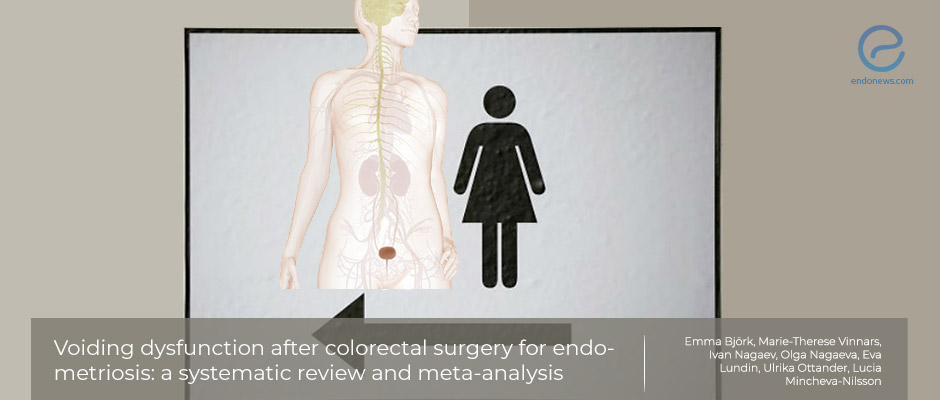Voiding Dysfunction after Colorectal Surgery for Endometriosis
Aug 12, 2020
Meta-analysis showed that rectal shaving causes less postoperative voiding dysfunction compared to other types of colorectal surgery for endometriosis.
Key Points
Highlights:
- Patients should be preoperatively informed about the significant deranging effects of bowel surgery for deep endometriosis on urinary function, regardless of the type of surgery.
Importance:
- The authors underline the importance of detecting urinary symptoms before surgery and defining a high-risk group by urodynamic testing before gastrointestinal deep endometriosis operations.
- They also encourage the usage of a consensual definition of "postoperative voiding dysfunction" and the indication for self-catheterization.
What's done here:
- A systematic review and meta-analysis evaluated the rates of voiding dysfunction sorted by the surgical approach for deep infiltrating endometriosis.
- Fifty-one studies including a total of 5962 patients undergoing surgery for deep endometriosis involving the colorectum were reviewed, 13 of them were included in this meta-analysis.
Key Results:
- The prevalence of voiding dysfunction was 2.4%, 7.5%, and 10.1% after rectal shaving, discoid excision, and segmental colorectal resection, respectively.
- Rectal shaving was associated with a lower risk of prolonged self-catheterization compared with segmental colorectal resection.
- Conservative surgery such as rectal shaving and discoid excision had a lower risk of postoperative voiding dysfunction compared to segmental colorectal resection.
Limitations:
- The criteria used for defining the "voiding dysfunction" may have a variable effect on the quality of the evidence.
- In most of the articles, voiding dysfunction before surgery was not taken into account.
- The accuracy and the validity of the results are subject to the heterogeneity between the studies.
Lay Summary
Postoperative voiding dysfunction is a less frequent complication of rectal shaving than that of discoid excision or segmental resection in patients undergoing colorectal surgery for endometriosis, regardless of its definition. This is according to a meta-analysis conducted by researchers from France and the USA.
Vesale E. and the team performed a systematic review of 51 studies, and included 13 of them for this meta-analysis, with the aim of evaluating the rates of voiding dysfunction grouped by the surgical approach, i.e. rectal shaving, discoid excision or colorectal segmental resection for deep infiltrating endometriosis. This study has recently been published in The Journal of Minimally Invasive Gynecology.
The researchers found that the estimated overall rate of voiding dysfunction was 7.6% after colorectal surgery for deep endometriosis.
Rectal shaving was found to be statistically significantly less associated with postoperative voiding dysfunction than segmental colorectal resection when the analysis is done regardless of the definition. The risk of prolonged self-catheterization was lower when compared with segmental colorectal resection. Conservative surgery (i.e. rectal shaving and discoid excision) was detected to have a lower risk of postoperative voiding dysfunction than radical surgery (i.e. segmental colorectal resection). According to eight studies, the median time of self-catheterization after segmental colorectal resection was more than 30 days.
The ratio of postoperative voiding dysfunction after conservative surgery with a nerve-sparing or a non-nerve-sparing technique was 4.4% and 1.8%, respectively. For radical surgery, postoperative voiding dysfunction after a nerve-sparing and a non-nerve-sparing technique was observed in 12.9% patients and 11.3% patients, respectively.
The authors stated that this study is the first to report the risk of postoperative voiding dysfunction comparing three approaches to colorectal surgery for endometriosis.
It is important to note that colorectal endometriosis, itself, also causes urinary dysfunction due to the hypogastric plexus involvement. Therefore, the authors recommend evaluation of the urinary function before surgery to differentiate preexisting from de novo voiding dysfunction occurring after surgery. They also indicate the importance of defining a high-risk group by urodynamic testing may be helpful. Finally, the authors underlined the necessity of using a consensual definition of "postoperative voiding dysfunction" and "indication for self-catheterization" which will be helpful in counseling patients and determining eligibility for a clinical trial.
Research Source: https://pubmed.ncbi.nlm.nih.gov/32730989/
endometriosis bowel involvement meta-analysis voiding dysfunction gastrointestinal endometriosis bowel endometriosis urinary tract endometriosis

